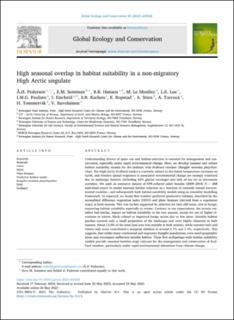| dc.contributor.author | Pedersen, Åshild Ønvik | |
| dc.contributor.author | Soininen, Eeva M | |
| dc.contributor.author | Hansen, Brage Bremset | |
| dc.contributor.author | Le Moullec, Mathilde | |
| dc.contributor.author | Loe, Leif Egil | |
| dc.contributor.author | Paulsen, I.M.G. | |
| dc.contributor.author | Eischeid, Isabell | |
| dc.contributor.author | Karlsen, Stein Rune | |
| dc.contributor.author | Ropstad, Erik | |
| dc.contributor.author | Stien, Audun | |
| dc.contributor.author | Tarroux, Arnaud | |
| dc.contributor.author | Tømmervik, Hans | |
| dc.contributor.author | Ravolainen, Virve | |
| dc.date.accessioned | 2023-07-17T10:50:46Z | |
| dc.date.available | 2023-07-17T10:50:46Z | |
| dc.date.created | 2023-06-07T12:50:39Z | |
| dc.date.issued | 2023 | |
| dc.identifier.issn | 2351-9894 | |
| dc.identifier.uri | https://hdl.handle.net/11250/3079621 | |
| dc.description.abstract | Understanding drivers of space use and habitat selection is essential for management and conservation, especially under rapid environmental change. Here, we develop summer and winter habitat suitability models for the endemic wild Svalbard reindeer (Rangifer tarandus platyrhynchus). The high-Arctic Svalbard tundra is currently subject to the fastest temperature increases on Earth, and reindeer spatial responses to associated environmental change are strongly restricted due to landscape barriers and lack of sea ice as movement corridors. We used an extensive dataset of GPS-collared adult females (2009-2018; n = 268 individual-years) to model seasonal habitat selection as a function of remotely sensed environmental variables across years, and subsequently built habitat suitability models using an ensemble modelling framework. In this archipelago, with 60% glacial coverage, we found as expected, that reindeer preferred, in both seasons, productive habitats described by the normalized difference vegetation index (NDVI) and plant biomass (derived from a vegetation map). This was further supported by selection of bird cliff areas, rich in forage, improving habitat suitability especially in winter. Contrary to our expectations, the terrain variables had similar, limited impact on habitat suitability in both seasons, except for use of higher elevations in winter, likely related to improved forage access due to less snow. Suitable habitat patches covered only a small proportion of the landscape and were highly clustered in both seasons. About 13.0% of the total land area was suitable in both seasons, while summer-only and winter-only areas contributed a marginal addition of around 4.7% and 1.5%, respectively. This suggests that unlike most other Rangifer populations, protection of even small geographic areas encompass both suitable summer and winter habitat. These first archipelago-wide habitat suitability models provide seasonal baseline maps relevant for the management and conservation of Svalbard reindeer, particularly under rapid environmental alterations from climate change. Biomod2, ENFA, NDVI, plant biomass, predictive habitat model, Rangifer tarandus platyrhynchus, SDM | |
| dc.language.iso | eng | |
| dc.title | High seasonal overlap in habitat suitability in a nonmigratory High Arctic ungulate | |
| dc.title.alternative | High seasonal overlap in habitat suitability in a nonmigratory High Arctic ungulate | |
| dc.type | Peer reviewed | |
| dc.type | Journal article | |
| dc.description.version | publishedVersion | |
| dc.source.journal | Global Ecology and Conservation | |
| dc.identifier.doi | 10.1016/j.gecco.2023.e02528 | |
| dc.identifier.cristin | 2152589 | |
| dc.relation.project | Egen institusjon: UiT - Arctic University of Norway | |
| dc.relation.project | Andre: Fram Centre | |
| dc.relation.project | EU – Horisont Europa (EC/HEU): EU 869471 | |
| dc.relation.project | Andre: Tromsø Research Foundation | |
| dc.relation.project | Egen institusjon: NTNU | |
| dc.relation.project | Egen institusjon: James Hutton Institute | |
| dc.relation.project | Norges forskningsråd: 223257 | |
| dc.relation.project | Norges forskningsråd: 276080 | |
| dc.relation.project | Norges forskningsråd: 267613 | |
| dc.relation.project | Egen institusjon: Norwegian institute for nature research (NINA) | |
| dc.relation.project | Egen institusjon: Norwegian Polar Institute | |
| dc.relation.project | Svalbards miljøvernfond: 315454 | |
| cristin.ispublished | true | |
| cristin.fulltext | original | |
| cristin.qualitycode | 1 | |
